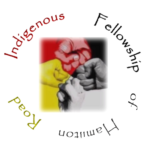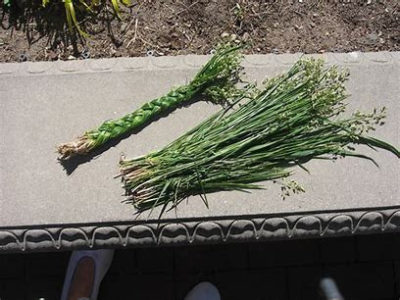Indigenous Fellowship of Hamilton Road


Sweetgrass
Sweetgrass is one of the main herbs used by Native people. It is often part of the medicine used when smudging along with sage and cedar . Just as sage is used to clear negativity, to cleanse, sweetgrass is used to bring positivity. At the healing circle I attend, we often start the circle by smudging using sage. As circles tend to be heavy (lots of trauma is shared), if we use sweetgrass, we use it at the end of the circle. To cleanse ourselves again and to bring back positivity and calm.
Therefore, sweetgrass represents positivity, strength, connection to the Creator and all our relations. it represents the Mother, our mother, Mother Earth. It is our connection to the land, to what is around us. Its smell when burned dry is a sweet smell, reminiscent of our ancestors. When fresh, its smell is one of grass (a faint one). It smells fresh, it smells like comfort and home. When braided, sweetgrass can represent a few different concepts. In the Cree-Ojibway culture, for example, the three braids of the sweetgrass can represent love, peace and harmony or mind, body and spirit.
Reference: Native American sweetgrass: Its meaning and use – traditional NATIVE HEALING. Traditional Native Healing | All my Relations. (2016, November 19). http://traditionalnativehealing.com/native-american-sweetgrass-its-meaning-and-use
Sweetgrass Teaching
Sweetgrass – a kindness medicine… has a sweet gentle aroma when we light it… 21 strands to make a braid… the first 7 strands represent those 7 generations behind us… our parents, grandparents… 7 generations behind us.. who we are and what we are is because of them.. they’ve brushed and made the trails we have been walking up till now… the old people tell us that it takes longer for us to heal today and the reason is because the old trails our ancestors used to use to find us have been destroyed… they’ve build dams which have destroyed the old trails… they’ve build towns and cities where the old trails used to be… so now our ancestors are having a harder time trying to find us to help us heal… the next seven represent the 7 sacred teachings… love, respect, honesty, courage, wisdom, truth, and humility… the old people tell us how simple, powerful and beautiful the teachings are… love- a very simple teaching… respect- a powerful teaching… humility- a beautiful teaching… when we truly understand the teaching of humility… that I am not any better then anyone else and you are not any better then me… that at the end of the day we are all simply human beings… this is what makes this teaching powerful and beautiful… the only thing wrong with the teachings is that we don’t walk them everyday… love is only a 4 letter word… it’s when we walk that love, when we show it, when we live it… that’s what makes these teachings powerful and beautiful… one other thing we are reminded is that how can we love someone else if we don’t First love ourself… how can we respect another if we don’t First respect ourself… they tell us that the teachings need to first start from within ourself… the last 7 strands… those 7 generation in front of us… our children, grandchildren… those children yet to be born… why are they important… everything we do to Mother Earth will one day affect them… right now the earth gives us everything and anything we can possibly want to have the life we have… but if we don’t look after her, what’s going to be left when it’s their turn… the circle that’s around me today, is that the same circle I want to pass on to them… especially if my circle involves alcohol abuse, drug abuse, family violence, lying, stealing or cheating… sometime it’s up to us to break the cycle… and hopefully replace it with something better …we put those 3 braids together… they represent yesterday, today and tomorrow… mind, body and spirit…. man, woman and child… man, woman and Creator ….
Reference: Aboriginal sacred plants: Sage. Indigenous Corporate Training Inc. (n.d.). https://www.ictinc.ca/blog/aboriginal-sacred-plants-sage
Language
Fouin dodeur in Michif
Iinashk+oon in Ojibwe
No translation in Oneida
Uses of Sweetgrass
Many Native tribes in North America use sweetgrass in prayer, smudging or purifying ceremonies and consider it a sacred plant. It is usually braided, dried, and burned. Sweetgrass braids smolder and doesn’t produce an open flame when burned. Just as the sweet scent of this natural grass is attractive and pleasing to people, so is it attractive to good spirits. Sweetgrass is often burned at the beginning of a prayer or ceremony to attract positive energies.
Densmore (1974) describes that among the Chippewa (Ojibwa), “young people, chiefly young men, carried a braid of sweet grass and cut off 2 or 3 inches of it and burned it for perfume. Young men wore two braids of sweet grass around their necks, the braids being joined in the back and falling on either side of the neck like braids of hair.”
Sweetgrass is used to “smudge”; the smoke from burning sweetgrass is fanned on people, objects or areas. Individuals smudge themselves with the smoke, washing the eyes, ears, heart and body. Mi’kmaq have long used sweetgrass as a smudging ingredient, often mixed with other botanicals. Sweetgrass is one of the four medicines which comprise a group of healing plants used by the people in Anishinabe, Bode’wad mi, and Odawa societies.
Among the Chippewa wicko’bimucko’si (sweetgrass) is braided and used in pipe-smoking mixtures along will red willow and bearberry, when it is burned, prayers, thoughts and wishes rise with the smoke to the creator who will hear them. Densmore (1974) describes the story of “a hunting incident in which a party of men placed sweet grass on the fire when the camp was in danger of starving and they were going again to hunt. Medicine men kept sweet grass in the bag with their medicinal roots and herbs”.
A tea is brewed by Native Americans for coughs, sore throats, chafing and venereal infections. It is also used by women to stop vaginal bleeding and to expel afterbirth. It is warned that because the roots contain coumarin, that sweetgrass tea may be considered a carcinogenic. (Foster & Duke 1990)
Frances Densmore (1974) explains that Among the Chippewa (Ojibwa), “strands of sweet grass were made into “coiled basketry” by means of cotton thread. This took the form of bowls, oval and round, and of flat mats. Birch bark was sometimes used as the center of such articles, the coils of sweet grass being sewed around it.”
Reference: Native American uses for Sweetgrass. NativeTech. (n.d.). http://nativetech.org/plants/sweetgrass.html